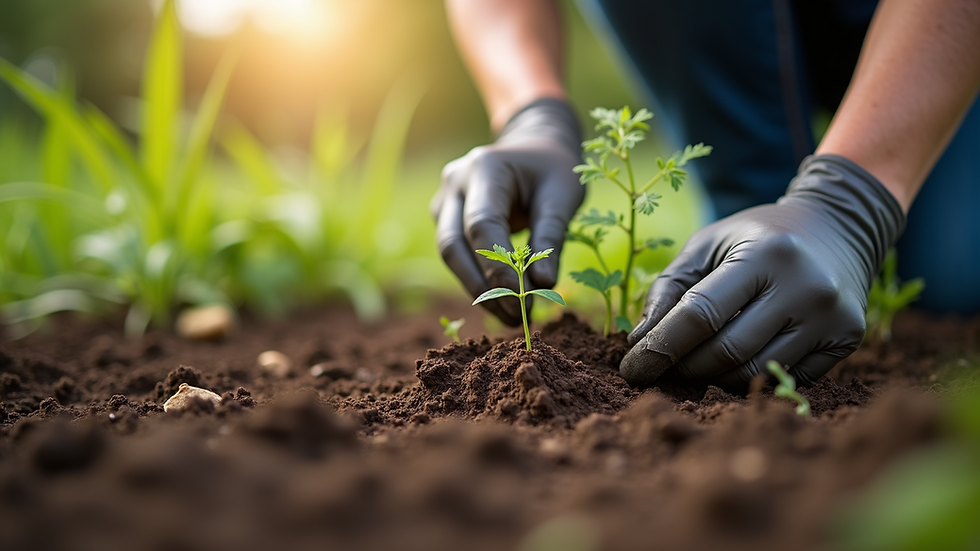From Seedlings to Harvest: A Guide to Farm Fresh Produce
- prettyorganicmo
- Aug 5
- 4 min read
Growing your own food can be one of the most rewarding experiences. Imagine stepping into your backyard and picking fresh tomatoes, crisp lettuce, or fragrant herbs. Not only does it provide a sense of accomplishment, but it also ensures that you have access to healthy, organic produce. In this guide, we will explore the journey from seedlings to harvest, offering practical tips and insights to help you cultivate your own farm fresh produce.
Understanding the Basics of Gardening
Before you start planting, it is essential to understand the basics of gardening.
Soil Quality: Good soil is the foundation of a successful garden. It should be rich in nutrients and have good drainage. You can improve your soil by adding compost or organic matter.
Sunlight: Most vegetables and fruits need at least six hours of sunlight each day. Observe your garden space to find the best spots for planting.
Watering: Consistent watering is crucial. Plants need moisture to grow, but overwatering can lead to root rot. Aim for deep watering once or twice a week.
Choosing the Right Plants: Start with easy-to-grow plants like tomatoes, peppers, or herbs. These are forgiving and can thrive even with minimal experience.
Starting with Seeds
Starting your garden from seeds can be a fun and cost-effective way to grow your own produce.
Selecting Seeds: Choose seeds that are suitable for your climate and growing season. Look for local seed companies or garden centers for recommendations.
Seedling Care: Once you have your seeds, plant them in seed trays or small pots. Keep them in a warm, sunny location and water them regularly.
Transplanting: When seedlings are about 2-3 inches tall and have a few leaves, they are ready to be transplanted into the garden. Be gentle when moving them to avoid damaging the roots.
Preparing Your Garden Bed
Creating a suitable garden bed is essential for healthy plant growth.
Location: Choose a spot that receives plenty of sunlight and is protected from strong winds.
Size: A raised bed can be a great option. It allows for better drainage and can be easier to manage. A common size is 4 feet by 8 feet.
Soil Preparation: Before planting, mix in compost and organic matter to enrich the soil. This will provide essential nutrients for your plants.
Planting Your Seeds or Seedlings
Now that your garden bed is ready, it’s time to plant.
Spacing: Follow the instructions on the seed packets for spacing. Crowding plants can lead to poor growth and disease.
Depth: Plant seeds at the recommended depth. Generally, smaller seeds should be planted shallower than larger seeds.
Watering After Planting: After planting, water the area gently to settle the soil around the seeds or seedlings.
Caring for Your Garden
Once your plants are in the ground, they will need ongoing care.
Weeding: Regularly check for weeds, as they compete for nutrients and water. Pull them out by hand or use a hoe.
Mulching: Adding a layer of mulch can help retain moisture and suppress weeds. Organic materials like straw or wood chips work well.
Fertilizing: Depending on the plants you are growing, you may need to fertilize. Use organic fertilizers to promote healthy growth.
Pest Management
Pests can be a gardener's worst nightmare.
Identifying Pests: Regularly inspect your plants for signs of pests. Look for holes in leaves or sticky residue.
Natural Remedies: Use natural pest control methods like neem oil or insecticidal soap. These are less harmful to beneficial insects.
Encouraging Beneficial Insects: Plant flowers that attract beneficial insects like ladybugs and lacewings. They can help control pest populations.
Harvesting Your Produce
The moment you have been waiting for is finally here.
Knowing When to Harvest: Each type of produce has its own signs of ripeness. For example, tomatoes should be fully colored and slightly soft to the touch.
Harvesting Techniques: Use sharp scissors or garden shears to cut fruits and vegetables. This helps prevent damage to the plant.
Storing Your Harvest: Store your produce properly to maintain freshness. Most vegetables do well in the refrigerator, while some fruits may need to be kept at room temperature.

Enjoying Your Farm Fresh Produce
After all your hard work, it’s time to enjoy the fruits of your labor.
Cooking with Fresh Ingredients: Use your fresh produce in salads, stir-fries, or sauces. The flavor of homegrown vegetables is often superior to store-bought.
Sharing with Friends and Family: Share your bounty with loved ones. It’s a great way to connect and spread the joy of gardening.
Preserving Your Harvest: If you have an abundance of produce, consider canning, freezing, or drying to enjoy it later.
The Joy of Gardening
Gardening is not just about growing food; it is also about connecting with nature.
Mindfulness: Spending time in the garden can be a form of meditation. It allows you to slow down and appreciate the beauty around you.
Learning Experience: Each season brings new challenges and lessons. Embrace the journey and learn from your successes and failures.
Community: Join local gardening clubs or online forums. Sharing experiences and tips can enhance your gardening journey.
Final Thoughts
Growing your own farm fresh produce is a fulfilling endeavor that can enhance your life in many ways. From the joy of planting seeds to the satisfaction of harvesting your crops, each step is a rewarding experience.
Whether you have a large backyard or a small balcony, there is always a way to grow your own food. Start small, be patient, and enjoy the process. Soon, you will be reaping the benefits of your hard work, one delicious bite at a time.
So grab your gardening gloves, and let’s get started on this exciting journey from seedlings to harvest!


Comments